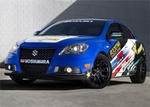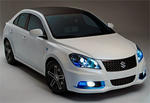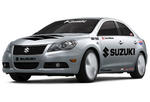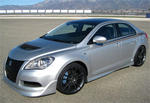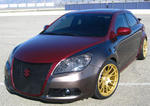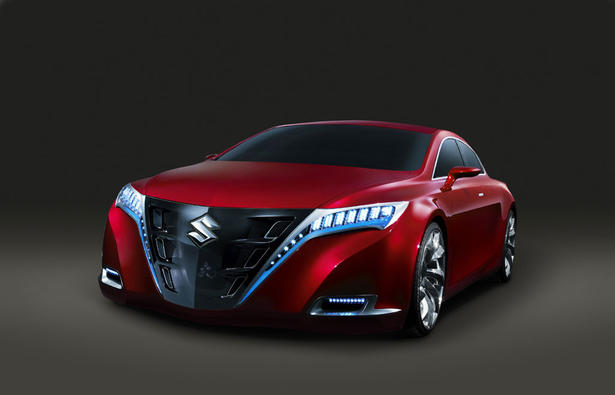
The Suzuki KIZASHI was presented at the IAA in Frankfurt to illustrate the progress Suzuki has made toward the developing of a D-segment entry. Kizashi in Japanese means "prelude" - symbolizing a change within Suzuki.
The Suzuki KIZASHI is powered by a 2.0 liter 4-valve turbo diesel engine and is equipped with a sequential six-speed transmission.
Suzuki Press release:
SUZUKI ENTERS NEW SEGMENT WITH KIZASHI CONCEPT
Highlights
The Kizashi concept, introduced at the 2007 Frankfurt Motor Show, illustrates Suzuki’s progress toward developing a new D-segment entry. The D-segment is divided into two categories: family-oriented cars characterized by cabin roominess and compact “entry luxury,” offering performance, prestige and quality. The new value that Suzuki will provide is unique to the segment in that it combines affordability and emotional appeal.
Kizashi is a Japanese word meaning “prelude” or “foretaste,” symbolizing a change within Suzuki.


Kizashi represents Suzuki's passion for challenges, its future direction and the competitive strength that is unique to the company.
The design theme for the Kizashi is “a dynamic athlete in motion.” In creating the Kizashi, Suzuki made a particular effort to express the car's prowess as a highway standout with large wheels and wide treads, expressing a capacity for high performance. A bonnet shape suggests abundant engine power, and an aerodynamic stance enables the car to cut through the air while firmly gripping the road.
Suzuki has made a name for itself in the compact car and sport utility vehicle segments. To respond to ever-changing customer demands and expectations, an automaker of Suzuki’s caliber must offer a wide range of products in order to accommodate customers' diverse lifestyles. As a result, Suzuki plans entries in segments from A to D in the next few years. With a new flagship sedan, Suzuki will further illustrate its high level of engineering and technological competence – bolstering its brand image globally.
Suzuki's “Way of Life!” brand promise translates into this new sedan based on five principles: “straightforwardness,” “value,” “sportiness,” “spirit” and “excitement.” Suzuki offers fun-to-drive, fun-to-own products that are sensible and worthwhile, while delivering character and emotional appeal.
The first phase of Suzuki’s world strategy focuses on “sportiness” and is embodied by the highly successful Swift, Grand Vitara and SX4.
The Splash will embody the second phase of Suzuki's world strategy, focused on “family,” a core Suzuki value, and also makes its world debut at the 2007 Frankfurt show. The next model in this family-centered, user-friendly phase is the
next-generation Alto, which combines environmental compatibility with agility.
The third phase of Suzuki’s world strategy focuses on “status” as a sign of the maturity of the brand, and it is embodied by Kizashi’s entry in the D-segment.
The Kizashi concept illustrates a high degree of “status” by featuring an appealing blend of cabin roominess, graceful styling, dynamism, character and a passionate spirit matched to Suzuki’s user-centered functionality and performance engineering excellence.
To respond to the global demand for environmental compatibility in the D-segment, Suzuki offers a hybrid car that achieves environmental compatibility without sacrificing an emotionally appealing engine feel. Intelligent all-wheel drive (i-AWD) will further heighten the car's refined dynamics. For an even better combination of environmental compatibility and dynamic performance, the i-AWD development targets include the lowest CO2 emissions of any D-segment AWD passenger car.
Technical Specifications:
Overall length (mm): 4,650
Overall width (mm): 1,950
Overall height (mm): 1,400
Wheelbase (mm): 2,850
Engine: Newly developed 2.0L 4-valve turbo diesel
Transmission: Sequential six-speed
Drive System: Advanced i-AWD
Tires: 255/30R21
Wheels: 21-inch, nine-spoke, aluminum-alloy
Suzuki Concept Kizashi, the World Premiere
The Third Phase of Suzuki's World Strategy
With the Swift, Suzuki began the first phase of its world strategy and gave undiluted form to the attribute that was the theme of the first phase: sportiness.
The Swift won awards around the world by virtue of its superior dynamics and design. Suzuki subsequently pursued sportiness in the Grand Vitara and SX4, and both cars enjoy enormous success.
The Splash is making its world debut at the 2007 Frankfurt show and will become the first model in the second phase of Suzuki's world strategy. In this phase, the theme is families. Having focused on sportiness in the first phase, enhancing Suzuki's image in the process, Suzuki is now building upon what they have already achieved while refocusing on its main traditional strength: family-oriented user-friendliness. The next model coming after the Splash is the next-generation Alto, which combines environmental compatibility with agility.
The D-segment initiative which is now being revealed represents the beginning of the third phase of the world strategy. The main objective of this phase is status. The brand has developed to such an extent that it's able to communicate status, and Suzuki has overcome the great challenge of making cars that give their owners a feeling of status.
1. Why is Suzuki Entering the D-Segment?
Suzuki has made a name for itself in the compact car and sport utility vehicle segments. Its customers spread in 168 countries and regions around the world. The annual sales have shown steady growth, rising from about 1,654 thousand units in fiscal 1997 to an estimated 2,405 thousand units in fiscal 2007.
Under the mid-term five-year plan, Suzuki is targeting sales of 3 million units in fiscal 2009 (the last year of the plan). The Japanese carmaker achieved consolidated sales of 3 trillion yen in fiscal 2007, meaning that the company is close to a mid-ranking position in the worldwide motor industry.
But despite the progress, Suzuki has not been able to accommodate many of the customers who have expressed a desire to stay with the automaker when purchasing subsequent, larger cars. Suzuki has entirely owed its customers for the growth since its founding in 1909. The carmaker feels obliged to respond to increasing expectations and is convinced that it's essential to offer a wider product range in order to accommodate customers' diverse lifestyles. Consequently, Suzuki has decided to expand its lineup to cover all segments from A to D in the next few years. Suzuki's first-ever D-segment car will stand at the top of the range.
Another major factor behind the D-segment entry is to more fully exploit the high level of Suzuki's technological competence and thus enhance its brand image.
2. Suzuki's D-Segment Entry
Suzuki realizes that there's no point in entering the D-segment unless it can offer new value that can't be given by any of the existing brands.
Suzuki paid close attention to the fact that the D-segment is broadly divided into two parts. In one part, there are family-oriented cars that are relatively large and reflect an emphasis on cabin roominess. In the other part, there are “entry luxury” cars that reflect an emphasis on performance, are relatively compact, and offer relatively high levels of quality and prestige. The new value that Suzuki intends to provide will not belong to either group.
Suzuki's “Way of Life!” brand slogan is based on five elements: “straightforward”, “value”, “sporty”, “spirit”, and “excitement”. The words “straightforward” and “value” reflect Suzuki's ability to offer products that are sensible and worthwhile. The words “sporty” and “spirit” reflect the emotional appeal of its products. And the word “excitement” expresses the core factor that Suzuki delivers to customers through all products. Among these factors, “value” (in other words, a level of customer satisfaction higher than the expected from products' prices), is an inherent virtue of Suzuki cars.
It might be argued that all existing D-segment cars whose affordability is a selling point are chosen by customers because they offer a good balance of pricing on one hand and the rational factors of equipment, driving performance, and cabin roominess on the other. But the Suzuki D-segment car will be different.
With the D-segment entry, Suzuki is targeting emotional appeal as a way to deliver a level of customer satisfaction far higher than what might be expected from the car's price point. In other words, Suzuki is the first carmaker to target an uncompromised combination of affordability and emotional appeal in the D-segment.
For sportiness, the car's dimensions need to reflect a priority on performance. So while ensuring the cabin roominess that is essential in the D-segment, the car is as lean as possible. And with regard to design, Suzuki has thoroughly studied the nature of sporty, exciting styling in the D-segment and has concluded that the design of the new car should have two themes: grace and dynamism.
Since the overall theme of the third phase of Suzuki's world strategy is status, the expressions of dynamism should not be brash expressions of power. Rather, they aim for styling that's rich in character and conveys a passionate spirit.
The sportiness that Suzuki wants to deliver in the D-segment will perhaps be most directly expressed by the car's dynamics. The kind of dynamics creates a sense of refinement. Suzuki's engineers are striving to devise ways to maximize the quality of the dynamics not only in performance but also in terms of motion that stirs people's emotions. This effort is vital because the kind of sportiness is measured not in terms of times and performance figures but in terms of how it makes people feel. Suzuki has already given form to this thinking in the Swift Sport. Now, they plan to carry it forward and further develop it for the D-segment.
3. The Engineering Approach Supporting Suzuki's New Initiative
In order to achieve its goals, Suzuki is taking a typically Suzuki-like technological approach. The methodology is to combine and apply proven technologies, thoroughly refining them in user-centered ways rather than pursuing features using spectacular new techniques.
This approach is actually one of the greatest benefits Suzuki has gained from its company's motorcycle business (Suzuki is one of only a handful of companies that produce both cars and motorcycles). With a motorcycle – where the man-machine interface is even more crucial than it is with a car – establishing the dynamics based on data alone is impossible. Rather, it's essential to conduct numerous road tests, verifying and interpreting each and every comment from testers and feeding the results back into the design. This method may appear outdated in an industry where virtual-reality technology has become mainstream. Since Suzuki's engineers worked on the Swift, they have been convinced that it's the best way to dramatically heighten the dynamic performance of Suzuki's cars and stir the emotions of users. These factors are behind our focus on delivering a D-segment car that's spirited.
At the same time, Suzuki is conscious of the great demand for environmental compatibility in the D-segment. The main response to this demand is the development of a hybrid car. Its goal is to use a hybrid arrangement (an internal combustion engine provides the main propulsion, and an electric motor provides assistance whenever extra power is needed) to achieve environmental compatibility without sacrificing an emotionally appealing engine feel.
Suzuki is planning to use all-wheel drive (AWD; a technology that Suzuki has refined over many years) to further heighten the car's refined dynamics. For an even better combination of environmental compatibility and dynamic performance, the AWD development targets include the lowest CO2 emissions of any D-segment AWD passenger car.
4. Suzuki D-Segment Preview: The Concept Kizashi
Suzuki unveils the progress of the new project, a concept car called the Concept Kizashi, at the 2007 IAA Frankfurt show.
Kizashi is a Japanese word meaning “prelude” or “foretaste”. The name symbolizes the change within Suzuki.
The Concept Kizashi represents Suzuki's passion for challenges (this is a major aspect of Suzuki's corporate culture), its future direction, and the competitive strengths that are unique to Suzuki.
To fulfill this mission, the design theme for the Concept Kizashi is “a dynamic athlete in motion”. This is because its D-segment ideals are summed up by the attributes of a great athlete: dedication to sporting challenges, physical strength that comes from hard daily training, a honed physique with no superfluous weight, and the presence and dignity of a champion.
Suzuki made a particular effort to express the car's credentials as a highway athlete:
1. Overwhelming presence that breaks the D-segment mould
The body brings to mind the lean, muscular physique of a top-class athlete, and a strongly protrusive front end communicates a dignified character.
2. An energetic look that immediately gives an idea of the car's dynamic performance
Large wheels and wide treads express a capacity for high performance. The bonnet shape hints at abundant engine power. And the body hints at aerodynamics that enable the car to punch through the air while firmly gripping the road.
3. A sense of character and status befitting Suzuki's flagship car
The detailing of individual parts gives a sense of exquisiteness and quality.
The Concept Kizashi is a clear sign of the great things to come from Suzuki as the D-segment initiative continues to take shape.






